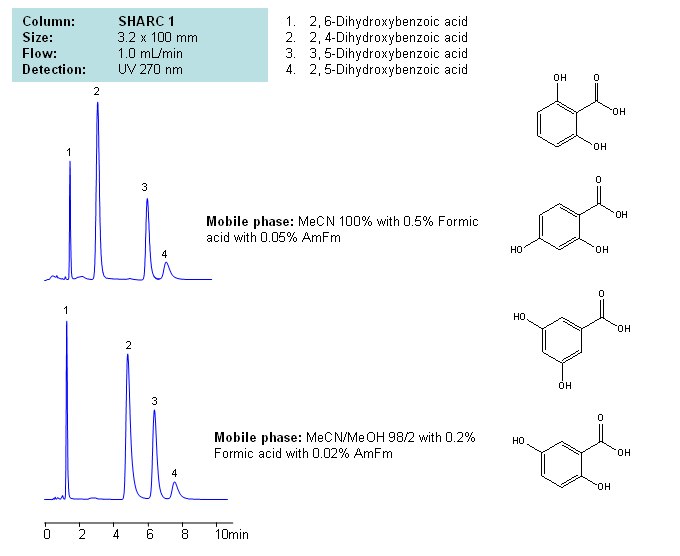
Application Notes: Dihydroxybenzoic acids are polar acidic compounds containing two hydroxyl groups as well as a carboxylic acid. Isomers of dihydroxybenzoic acids are very polar with varying degrees of acidity. While the isomers can be analyzed by mixed-mode chromatography on Primesep D column, the presence of hydroxyls and carboxylic acid fragments also make these compounds good candidates for using the new hydrogen bonding columns for analysis. Since all these compounds have the same amount of hydroxyls they are separated based on accessibility of this hydroxyl group. Retention time can be adjusted by the amount of ACN, MeOh and concentration of additives (formic acid, ammonium formate, triethylamine, etc.). Our method is fully compatible with LC/MS and prep chromatography and can be used for other hydroxy and carboxylic acids containing compounds..
Application Columns: SHARC 1, 3.2×100 mm, 5 um, 100A. To learn more about SHARC 1 columns click here. To order this column click here. To see more chromatographic separations check our web site.
Application Compounds: 2,6-dihydroxybenzoic acid, 2,4-dihydroxybenzoic acid, 3,5-dihydroxybenzoic acid, 2,5-dihydroxybenzoic acid
Detection Technique: UV, LC/MS
| Column | Sharc 1, 3.2×100 mm, 5 µm, 100A |
| Mobile Phase | MeCN/MeOH |
| Buffer | AmFm, Formic acid |
| Flow Rate | 1.0 ml/min |
| Detection | UV, 270 nm |
| Class of Compounds |
Drug, Acid, Hydrophilic, Ionizable, Vitamin, Supplements |
| Analyzing Compounds | 2,6-dihydroxybenzoic acid, 2,4-dihydroxybenzoic acid, 3,5-dihydroxybenzoic acid, 2,5-dihydroxybenzoic acid |
Application Column
SHARC 1
Column Diameter: 3.2 mm
Column Length: 100 mm
Particle Size: 5 µm
Pore Size: 100 A
Column options: dual ended
2,5-Dihydroxybenzoic Acid
3,5-Dihydroxybenzoic Acid





